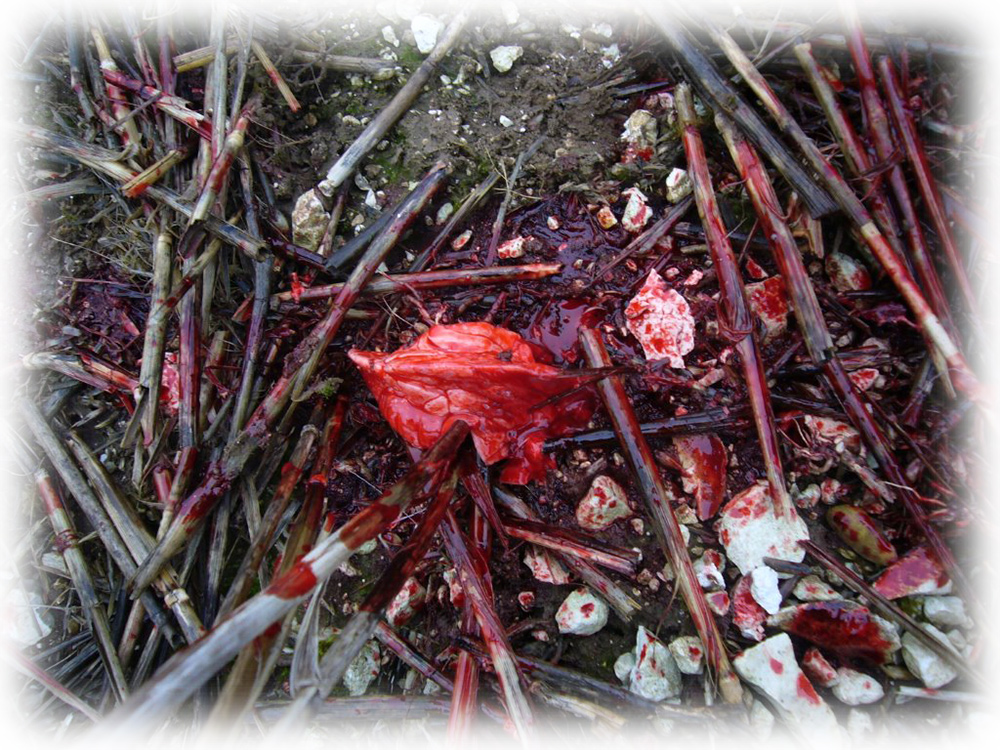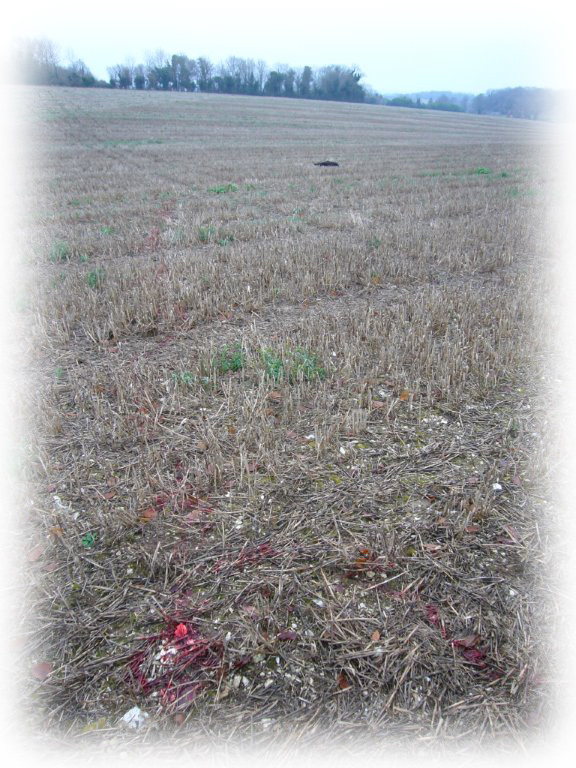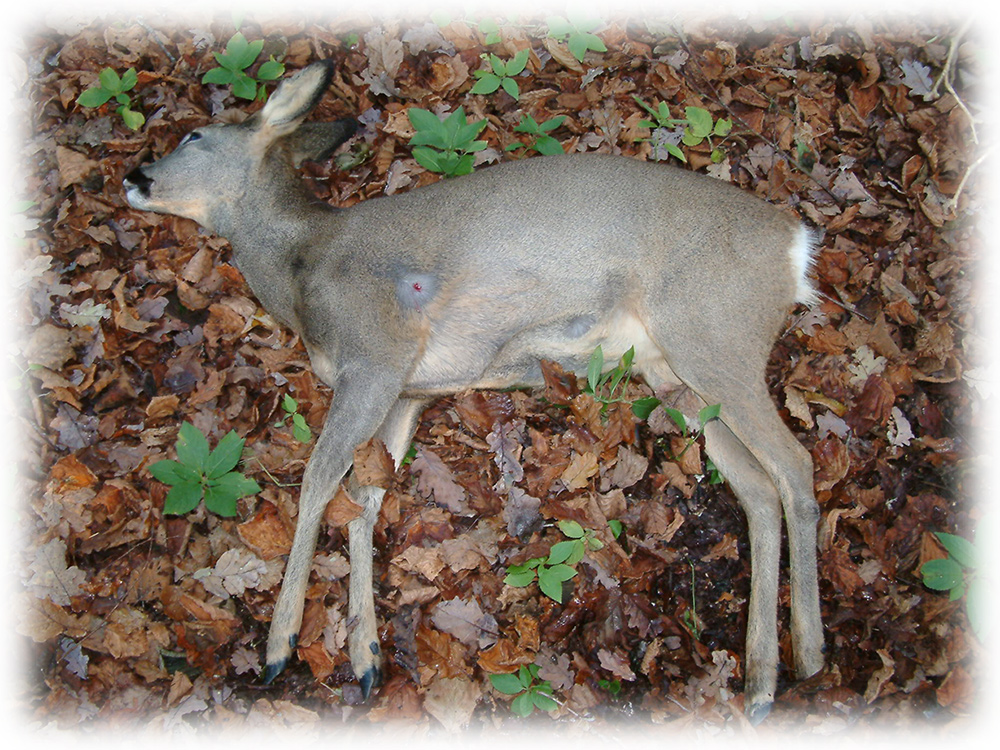
Introduction
Culled deer are normally killed with a single humane shot, therefore, in the vast majority of cases, the follow up of shot deer is simply a means of retrieving the dead animal.
However, it is important that stalkers are able to deal with the rare cases when a shot is misplaced, enabling the animal to be dispatched as soon as possible. Similar skills can be used to follow up deer that are sick or injured e.g. by road traffic accidents.
This guide describes a follow up procedure that will ensure that dead deer are found efficiently, but that can be adapted to a situation where the deer is injured.
The Shot Placement and Dogs for Deer guides should be considered important companion reading to this guide.

At the shot
A calm approach at the time of the shot can assure that any subsequent follow up is as efficient as possible.
- Before the shot, take a moment to mentally fix exactly where the deer is standing.
- Ensure that the shot is safe and that no other animals will be hit by the exiting bullet or fragments.
- When the shot is taken, watch for signs of impact and the initial reaction of the deer through the telescopic sight.
- Impressions may be fleeting but are usually accurate.
- Listen for the bullet strike, this is much easier if using a sound moderator.
- Reload immediately. Watch the deer carefully. Be ready to fire a second shot if required. Only target a new deer if satisfied that the first is dead.
- A common reaction to a lethal chest shot is that the deer will run a short distance, then collapse, dead. If the deer runs, note where it stops or disappears from view. In cover listen for any reflex kicking of the dead deer on the ground.
Always assume that every deer that has been shot at was hit, even if it shows no reaction or runs off with no sign of being hit. Every deer shot at must be followed up.

Reaction to shot
Precisely how deer react to being shot varies according to their physical condition, state of mind, where the bullet struck, and angle of the shot. The calibre and type of bullet used and the range may also have an effect.
Animals may react differently depending on their surroundings, their awareness of the stalker or the presence of other deer.
Table 2 describes how a deer may react to the shot, gives indicators of where it was probably struck and what action to take after the shot.
Procedure after the shot
General
If a second shot is required it must be safe. A static head shot from short range is preferred, however a shot to any part of the body which will mean that a quick death is assured, is acceptable. It may even be necessary to take the second shot at a moving deer, using care to ensure safety.
Avoid shooting deer late in the evening if there will be insufficient daylight to conduct a follow up. If it is getting dark when the shot is taken, be prepared to follow up immediately using a dog. It is very difficult to follow a blood trail in torchlight without a dog. In poor light a white tissue wiped over the blood trail may make blood easier to identify. Modern blood sensitive or thermal imaging methods can be used but only in conjunction with the procedures in the next section.
If a blood trail has to be followed in good light but without a dog, make sure that the next piece of evidence has been seen before moving from the last, it is all too easy to guess where the deer went, to take short cuts, and end up losing the trail altogether. Keep to one side so as not to spoil the scent trail and place markers just off the trail. If there is no obvious trail or if the trail runs out, do not begin searching at random, mark the last known position of the deer, fetch a dog at the earliest opportunity and begin tracking from the strike.
Never give up on a lost deer until it is either found or all reasonable means of finding it have been exhausted.
Procedure 1. Deer thought to be dead
- Stay in place, and wait for a few minutes. This will allow things to settle and other deer to depart the area if it is important that they are not disturbed. Mentally mark where the deer was standing when shot, and where it was last seen. Mark the firing point either mentally or with a conspicuous marker. Keep a watch in case the animal unexpectedly rises, in which case shoot it again.
- When the time comes to move, carry the rifle, loaded and safe. Reduce the magnification of a variable power scope in case a moving or close quarters shot has to be taken.
- If the deer can be seen or it’s precise position is known , quietly approach the spot where the deer dropped, preferably from downwind and from behind. Look out for a safe background in case a second shot is required.
- If the deer is not visible move as quietly and directly as possible to the place where the deer was standing when it was shot (the “strike”). Watch for the deer at intervals using both the naked eye and binoculars. If the deer is not there mark the location of the strike and examine the evidence (see Table 1).
- If the evidence indicates a lethal shot, follow the blood trail, or go to where the deer disappeared and proceed from there. Watch for the deer. When it is spotted check carefully for signs of life and even if there are none, re-check occasionally, approaching preferably from behind and down wind but always looking for a safe background should a second shot be required.
- Confirm that the animal is dead.
- If there is no evidence at the strike and/or no blood trail, or if at any stage it becomes obvious that the deer is wounded but is not visible go to Procedure 2. at paragraph 4. If, at any stage, the deer is found alive, go to the start of Procedure 2.
Procedure 2. Deer thought to be wounded
- When possible, if safe to do so, the deer should be shot again, even if it is moving.
- If it is not possible to shoot again and the deer is in sight and running, wait, in case the chance of a clear, safe shot develops. If the chances of a second shot can be improved by moving, only do so if the deer will not be frightened into running even further away.
- if the deer has fallen on the spot, and a quick second shot is not possible, consider approaching it immediately in case it is able to regain it’s feet. Do not do this unless it can be reached quickly. Move quietly and in as direct a line as possible, watching for the deer, paying attention to safety while moving and looking for a safe background to shoot against.
- If the precise location of the deer is not known, wait for at least 30 minutes from the time of the shot (see second bullet in 5. below). Keep a watch in case it rises, in which case shoot it again. Note where the deer was standing when shot, and where it was last seen. Mark where the rifle muzzle was at the time of the shot so that it can be seen from the strike. This will help both to confirm the trajectory of the bullet between the muzzle and the strike, and to re-locate the firing point if a re-appraisal of the situation becomes necessary.
- Carry the rifle as in Procedure 1, section 2. Move quietly and as directly as possible to the strike. Watch for the deer at intervals using both the naked eye and binoculars. If the deer is not there, mark the location of the strike and examine the evidence. Do not:
• start a random search, hoping to stumble across the deer
• pursue a mobile wounded deer that is aware it is being chased, or rush to trail a deer that is not visible. It is not in the interests of the deer to risk alarming it into running further away, making it harder to find. Far better to leave it undisturbed while a dog is fetched, help is found(if required) and the follow up is planned.
• shoot at any other deer while searching for the first
When searching for a wounded deer in dense undergrowth, it may be worth enlisting the help of others to cover possible escape routes. Use good communications and take great care to ensure safe fields of fire. - Use a dog, on a leash, to help follow the trail (see the Dogs for deer guide). There may be occasions when a dog is not available, if that is the case and there is an obvious blood trail, follow it, always watching for the deer. If there is no obvious strike or trail, or if the trail runs out, do not begin searching at random, fetch a dog as soon as possible and begin tracking from the strike.
- When the deer is spotted, check carefully for signs of life. Even if there are none, re-check occasionally, approaching preferably from behind and down wind but always looking for a safe background should a second shot be required.
If the deer is alive, take care to avoid alerting it, then shoot it from the position which gives the clearest possible shot and has a safe backstop. Be sure that the dog is safe. - Confirm that the animal is dead.
Humane dispatch
The rifle used for the initial shot must be legal for use on that species of deer (see Legislation and Shooting deer guides). A similar rifle is the preferred method of humane dispatch during normal culling operations, there is usually no need to carry alternative methods of dispatch except perhaps for a knife for moribund animals. The methods used to dispatch deer in other situations are described in the Deer Vehicle Collisions guide.
Legislation
When searching for a lost deer, avoid crossing into areas where you have no permission to be, particularly with a firearm. If a deer is shot and runs across a boundary, permission of the adjacent landowner/occupier must be sought before entering the land and the question of ownership of the carcass should be discussed.
Use of dogs
A dog must be available for following wounded deer. See the Dogs for Deer guide.
Evidence at the strike and on the trail
Approach the strike very carefully. Begin looking for signs before arriving on the spot, it is very easy to walk right over them. Evidence found at the strike and on the blood trail often gives a good indication of how the animal has been hit, see also Table 2.
Table 1
| Blood: | Bright red arterial blood |
|---|---|
| Light red frothy-lungs | |
| Dark thick blood - liver | |
| Thin, watery, especially if tinged with green stomach/intestine | |
| Wiping with a white tissue can reveal unseen blood or confirm suspect blood | |
| Hair : | May be separate hairs or possibly clumps attached to skin or muscle |
| Hair from different parts of the body may indicate where the deer was hit or where the bullet exited | |
| Hair from the bullet entrance is often cut by the bullet, hair from the exit often has intact roots or is attached to fragments of skin | |
| A grazing shot tends to produce a lot of hair | |
| Tissue: | Light pink, spongy - lungs |
| Dark, slimy liver | |
| Red, sticky muscle | |
| Stomach/Intestine: | Green or brown gut contents, often with small amounts of blood (be aware that the oesophagus (foodpipe) may be broken in a normal, lethal, heart/lung shot) |
| Bone: | Size and shape of fragments may indicate where hit |
| Leg bones-usually long splinters with tightly curved radius | |
| Rib and jaw bones tend to be flatter in section and more spongy inside | |
| Bone is dense and may travel much further than other tissue. . It may be bright white and very visible. |
Reaction to a normal accurate shot. The animals will be dead within seconds, the follow up is usually straightforward
Table 2
| Reaction | Likely placement of shot | Action | Typical signs at strike |
|---|---|---|---|
| Rear legs kick out, deer goes into head down gallop, collapses, often within 50 m. Head remains flat to the ground | Heart/ lung1 | Procedure 1 | Bright red blood, lung material, flank hair, some muscle, rib bone, usually a strong blood trail, |
| Deer shivers, staggers or spins on spot and collapses or walks a short distance, lays down then rolls over. Head remains flat to the ground | Heart/lung1 | Procedure 1 | As above |
| Rear legs kick out, deer goes into head down gallop, collapses, sometimes after 150m. Head remains flat to the ground | High lung1 | Procedure 1 | Bright red blood, lung material, flank/back hair, some muscle, rib bone, blood trail may be less strong and become indistinct |
| Front (and sometimes rear) legs leave ground, deer goes into head down gallop, may travel further than 100m, then collapses. Head remains flat to the ground | Low heart/brisket1 | Procedure 1 | Large amounts of hair from low on flank, bright blood, rib/brisket bone. Trail may be indistinct, |
| Instant collapse, deer rolls forward onto chest first, head remains flat to ground | Forward shoulder and/or forelegs(s)1, occasionally heart lung1 | Procedure 1 | Bright red blood, lung material, flank hair, some muscle, may be bone splinters, animal dead on the spot |
| Instant collapse, whole deer appears to hit ground at once, head remains flat to ground | Head1, neck1 | Procedure 1 | Head or neck hair, some bone, brain or spinal cord, no blood trail , animal dead on the spot |
Occasionally a shot may be misplaced. This should be very rare but the shooter must know how to deal with the incident.
Table 3
| Reaction | Likely placement of shot | Action | Typical signs at strike |
|---|---|---|---|
| Deer staggers at front, or collapses but with head up. May get up and stand or run with foreleg hanging straight or swinging out of position. May appear to run normally. | Lower foreleg4, foreleg/brisket3 | Procedure 2 | Short hair from leg and sometimes a lot of brisket hair, little bright blood, splinters of long bone, trail thins out quickly, especially after animal has laid down. |
| Instant collapse but head comes up. May struggle on ground or move off using hind legs only | Both forelegs/brisket3 | Procedure 2 | As above |
| Instant collapse, head may be flat to the ground at first but comes back up. May roll onto back, or lay still at first but then struggle, may regain feet and run | Clipped head2, spine2 or top of neck2 | Procedure 2 | Head, neck or back hair, little or no blood , possibly some small bone fragments or muscle |
| Instant collapse, rear end hits ground first, head held up, may move off using front legs only | Haunch3, spine2 3, rear leg4 | Procedure 2 | Back/leg hair, much muscle, bone splinters, little bright blood, blood trail indistinct |
| After attempted neck shot deer does not drop or drops then runs | Throat4, clipped top of neck2 | Procedure 2 | Neck hair, very little blood. Contents of oesophagus indicates throat. |
| After attempted head shot , may drop or show very little reaction, may turn round on the spot or run, possibly with jaw dropped | Jaw4, throat4 | Procedure 2 | Very little hair, blood or muscle, sometimes teeth or fragments |
| Strike accompanied by a dull thud. Deer hunches or may jump. Stands hunched or walks off slowly with a stilted gait. Usually couches nearby, head up or turned against flank. | Liver/gut3 | Procedure 2 | Small amount of dark blood, gut contents, sometimes liver, flank/belly fur, blood trail is spots only, sometimes larger pools where animal paused/rested |
| Deer remains still, behaving normally, head up and alert, or runs then stands alert, perhaps giving alarm call | Miss 2 | Procedure 2 | None found after a thorough search, dog indicates that the deer was not hit |
1 will be found dead
2 animal may recover but must still be searched for and dispatched if possible
3 animal is usually either dead or found and dispatched quickly
4 trail may be difficult to follow
[printfriendly]